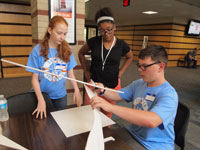Dear Colleagues,
The Tulsa Regional STEM Alliance had a busy June filled with summer camps, visits with business and community partners and ending with a great article in the Tulsa World, Tech-oriented workers in high demand, study shows. Below are some key updates from the month.
Innovation Rooms Updates
IR TRSA STEM Mentoring Logistics
Working to have some mentoring pilot programs for the fall with Union Public Schools.
Met with Victoria Bartlett to learn more about the Mayor’s Mentoring to the Max program as well as learning more about past and present mentoring programs.
Multiple meetings on starting a pilot Engineering Alliance for the Arts (EAA) in Tulsa:
Meeting with Wallace Engineering
Teleconference with EAA leaders out of San Francisco
Meetings with Union Public Schools and Tulsa Public Schools to find out about their past and present STEM Mentoring programs.
Meeting with the Tulsa Regional Chamber to investigate future STEM Mentorship partnerships.
Explored future STEM Mentorship partnership with Tulsa Tech leaders.
General Updates
Met with Kathy Taylor and Monroe Nichols with Impact!Tulsa to explore areas of collaboration between TRSA and Impact!Tulsa
Discussed data metrics and that possibility of organizing a data council
Teleconference with US2020
Overview of Judges’ feedback from Round 2 of the City Competition
Covered planning and implementation of TRSA so far.
TRSA key strategies to accomplish goals
Preview of Convening 1 in Boston on 7/8/14–7/9/14
6/30/14 – Conducted interview with Tulsa World on the role of STEM jobs in Tulsa’s economy
New Collaborations
Presented TRSA Business Plan, Advisory Council and Mentorship Initiative to Matrix , Williams, APSCO and NORDAM
Enthusiastic about participating on the Advisory Council
Smartsheets
Please take a chance to look at our growing list of TRSA Smartsheets. If you’d like have access to the Smartsheets, please contact Annie Tyndall, OII / TRSA Communications & Marketing Coordinator at [email protected].
Tulsa STEM Activities Sheet
TRSA Summer STEM Activities
TRSA STEM Employment Opportunities
TRSA Spring Break STEM Activities
TRSA Speakers’ Bureau
TRSA Communication IR
STEM Outreach Evaluations
STEM Mentoring […]



